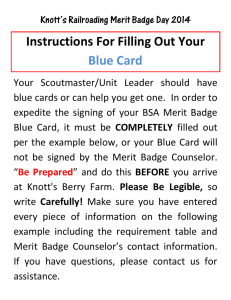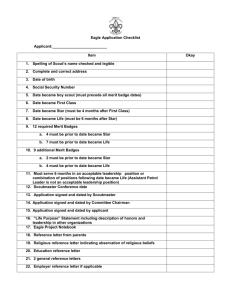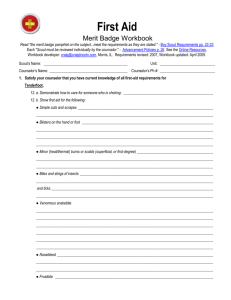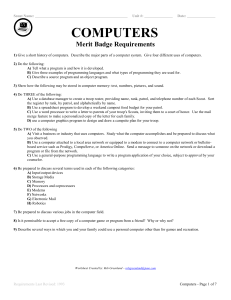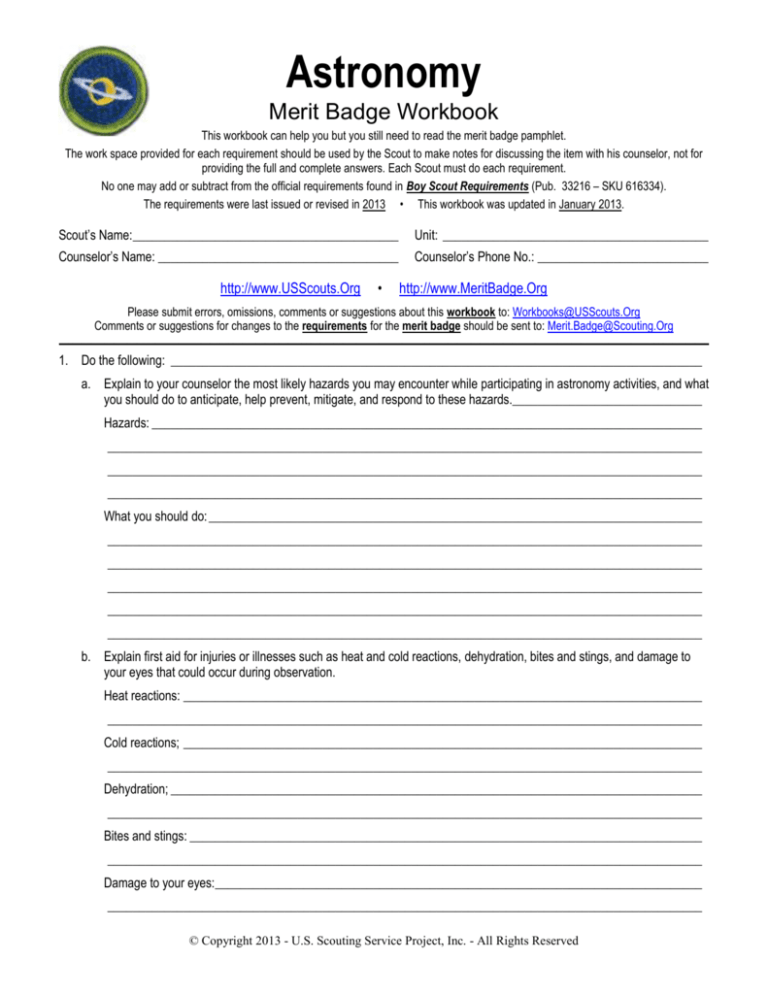
Astronomy
Merit Badge Workbook
This workbook can help you but you still need to read the merit badge pamphlet.
The work space provided for each requirement should be used by the Scout to make notes for discussing the item with his counselor, not for
providing the full and complete answers. Each Scout must do each requirement.
No one may add or subtract from the official requirements found in Boy Scout Requirements (Pub. 33216 – SKU 616334).
The requirements were last issued or revised in 2013 • This workbook was updated in January 2013.
Scout’s Name:__________________________________________
Unit: __________________________________________
Counselor’s Name: ______________________________________
Counselor’s Phone No.: ___________________________
http://www.USScouts.Org
•
http://www.MeritBadge.Org
Please submit errors, omissions, comments or suggestions about this workbook to: Workbooks@USScouts.Org
Comments or suggestions for changes to the requirements for the merit badge should be sent to: Merit.Badge@Scouting.Org
______________________________________________________________________________________________________________________________________________
1. Do the following: ____________________________________________________________________________________
a. Explain to your counselor the most likely hazards you may encounter while participating in astronomy activities, and what
you should do to anticipate, help prevent, mitigate, and respond to these hazards.______________________________
Hazards: _______________________________________________________________________________________
______________________________________________________________________________________________
______________________________________________________________________________________________
______________________________________________________________________________________________
What you should do: ______________________________________________________________________________
______________________________________________________________________________________________
______________________________________________________________________________________________
______________________________________________________________________________________________
______________________________________________________________________________________________
______________________________________________________________________________________________
b. Explain first aid for injuries or illnesses such as heat and cold reactions, dehydration, bites and stings, and damage to
your eyes that could occur during observation.
Heat reactions: __________________________________________________________________________________
______________________________________________________________________________________________
Cold reactions; __________________________________________________________________________________
______________________________________________________________________________________________
Dehydration; ____________________________________________________________________________________
______________________________________________________________________________________________
Bites and stings: _________________________________________________________________________________
______________________________________________________________________________________________
Damage to your eyes:_____________________________________________________________________________
______________________________________________________________________________________________
© Copyright 2013 - U.S. Scouting Service Project, Inc. - All Rights Reserved
Astronomy
Scout's Name: ________________________
c. Describe the proper clothing and other precautions for safely making observations at night and in cold weather. ______
Night: _________________________________________________________________________________________
______________________________________________________________________________________________
Cold Weather: ___________________________________________________________________________________
______________________________________________________________________________________________
Then explain how to safely observe the Sun, objects near the Sun, and the Moon. _____________________________
______________________________________________________________________________________________
______________________________________________________________________________________________
______________________________________________________________________________________________
______________________________________________________________________________________________
______________________________________________________________________________________________
2. Explain what light pollution is and how it and air pollution affect astronomy. _______________________________________
__________________________________________________________________________________________________
__________________________________________________________________________________________________
__________________________________________________________________________________________________
3. With the aid of diagrams (or real telescopes if available), do each of the following:
a. Explain why binoculars and telescopes are important astronomical tools. _____________________________________
______________________________________________________________________________________________
______________________________________________________________________________________________
______________________________________________________________________________________________
______________________________________________________________________________________________
Demonstrate or explain how these tools are used. _______________________________________________________
______________________________________________________________________________________________
______________________________________________________________________________________________
______________________________________________________________________________________________
Astronomy - Merit Badge Workbook
Page. 2 of 12
Astronomy
Scout's Name: ________________________
b. Describe the similarities and differences of several types of astronomical telescopes, including at least one that observes
light beyond the visible part of the spectrum (i.e., radio, X-ray, ultraviolet, or infrared). ___________________________
______________________________________________________________________________________________
______________________________________________________________________________________________
______________________________________________________________________________________________
______________________________________________________________________________________________
______________________________________________________________________________________________
______________________________________________________________________________________________
______________________________________________________________________________________________
c. Explain the purposes of at least three instruments used with astronomical telescopes.
______________________________________________________________________________________________
______________________________________________________________________________________________
______________________________________________________________________________________________
______________________________________________________________________________________________
d. Describe the proper care and storage of telescopes and binoculars both at home and in the field. __________________
______________________________________________________________________________________________
______________________________________________________________________________________________
______________________________________________________________________________________________
______________________________________________________________________________________________
4. Do the following:
a. Identify in the sky at least 10 constellations, at least four of which are in the zodiac.
______________________________________________________________________________________________
______________________________________________________________________________________________
______________________________________________________________________________________________
b. Identify at least eight conspicuous stars, five of which are of magnitude I or brighter.
Name of star
Magnitude
1. _________________________________________ ___________________________________________________
2. _________________________________________ ___________________________________________________
3. _________________________________________ ___________________________________________________
4. _________________________________________ ___________________________________________________
5. _________________________________________ ___________________________________________________
6. _________________________________________ ___________________________________________________
7. _________________________________________ ___________________________________________________
8. _________________________________________ ___________________________________________________
Astronomy - Merit Badge Workbook
Page. 3 of 12
Astronomy
Scout's Name: ________________________
c. Make two sketches of the Big Dipper. In one sketch, show the Big Dipper’s orientation in the early evening sky. In
another sketch, show its position several hours later. In both sketches, show the North Star and the horizon. Record the
date and time each sketch was made.
Date:___/___/___ Time: _____
Date:___/___/___ Time: _____
North Star
West
North
East
Suggested procedure:
Choose a clear night when you will have time and the ability to make observations some hours apart. Looking north, draw
the position of the Big Dipper with relation to the North Star. Note the time next to it. Several hours later (six hours are best
but at least four hours and preferably more than five hours) draw the position of the big dipper with relation of the North Star
and note the time next to it. (Be sure to clearly identify which diagram represents which observation)
d. Explain what we see when we look at the Milky Way. ____________________________________________________
______________________________________________________________________________________________
______________________________________________________________________________________________
______________________________________________________________________________________________
______________________________________________________________________________________________
______________________________________________________________________________________________
______________________________________________________________________________________________
______________________________________________________________________________________________
______________________________________________________________________________________________
Astronomy - Merit Badge Workbook
Page. 4 of 12
Astronomy
Scout's Name: ________________________
5. Do the following:
a. List the names of the five most visible planets. Explain which ones can appear in phases similar to lunar phases and
which ones cannot, and explain why.
Five Most Visible Planets
Phases?
Why?
________________________ ___________ __________________________________________________________
________________________ ___________ __________________________________________________________
________________________ ___________ __________________________________________________________
________________________ ___________ __________________________________________________________
________________________ ___________ __________________________________________________________
b. Using the Internet (with your parent's permission), books, and other resources, find out when each of the five most
visible planets that you identified in requirement 5a will be observable in the evening sky during the next 12 months, then
compile this information in the form of a chart or table.
Planet Name
Month
c. Describe the motion of the planets across the sky. ______________________________________________________
______________________________________________________________________________________________
______________________________________________________________________________________________
______________________________________________________________________________________________
______________________________________________________________________________________________
______________________________________________________________________________________________
______________________________________________________________________________________________
______________________________________________________________________________________________
______________________________________________________________________________________________
Astronomy - Merit Badge Workbook
Page. 5 of 12
Astronomy
Scout's Name: ________________________
d. Observe a planet and describe what you saw. __________________________________________________________
______________________________________________________________________________________________
______________________________________________________________________________________________
______________________________________________________________________________________________
______________________________________________________________________________________________
______________________________________________________________________________________________
______________________________________________________________________________________________
6. Do the following:
a. Sketch the face of the Moon and indicate at least five seas and five craters. Label these landmarks.\
Astronomy - Merit Badge Workbook
Page. 6 of 12
Astronomy
Scout's Name: ________________________
b. Sketch the phase and the daily position of the Moon, at the same hour and place, for four days in a row. Include
landmarks on the horizon such as hills, trees, and buildings.
Date:___/___/___ Time: _____
Date:___/___/___ Time: _____
Date:___/___/___ Time: _____
Date:___/___/___ Time: _____
East
South
West
Suggested procedure:
First check to see whether it is a morning or evening moon and chose a time to view the moon. Avoid an
observation period when there will be a new moon. Choose a time and place you are going to be able to
observe the moon each day. On the first day, sketch the relative position of the moon across the southern
horizon noting its height and shape (phase). Draw some landmarks on the sketch as points of reference. On the
same drawing, repeat this at the same time each day for the next three days, showing the height and shape of
the moon for each observation. Note the date and time of your observation next to each sketch of the moon. If
the sky is overcast and the moon is not visible, either extend the observations until you can make four of them,
and/or using the other observations, estimate where the moon would have been and what shape it would have
been on the overcast day(s) and indicate that what is an estimate due to overcast sky.
Explain the changes you observe. ___________________________________________________________________
______________________________________________________________________________________________
______________________________________________________________________________________________
______________________________________________________________________________________________
______________________________________________________________________________________________
______________________________________________________________________________________________
______________________________________________________________________________________________
Astronomy - Merit Badge Workbook
Page. 7 of 12
Astronomy
Scout's Name: ________________________
List the factors that keep the Moon in orbit around Earth. _________________________________________________
______________________________________________________________________________________________
______________________________________________________________________________________________
______________________________________________________________________________________________
______________________________________________________________________________________________
______________________________________________________________________________________________
______________________________________________________________________________________________
______________________________________________________________________________________________
______________________________________________________________________________________________
______________________________________________________________________________________________
______________________________________________________________________________________________
d. With the aid of diagrams, explain the relative positions of the Sun, Earth, and the Moon at the times of lunar and solar
eclipses, and at the times of new, first-quarter, full, and last-quarter phases of the Moon.
Editor’s Note: These diagrams can be used to show the relative positions of the Sun, Earth, and Moon during the new,
first-quarter, full, and last-quarter phases of the Moon as well as during the Waxing Gibbous”, “Waning Gibbous”,
“Waxing Crescent”, and “Waning Crescent” phases of the Moon (which is not required for the merit badge). Two of the
diagrams can be used to show the positions both for a phase of the Moon and during an eclipse.
Astronomy - Merit Badge Workbook
Page. 8 of 12
Astronomy
Scout's Name: ________________________
7. Do the following:
a. Describe the composition of the Sun, its relationship to other stars, and some effects of its radiation on Earth’s weather
and communications.
Composition: ____________________________________________________________________________________
______________________________________________________________________________________________
Relationship to other stars: _________________________________________________________________________
______________________________________________________________________________________________
Effects on Earth’s weather: _________________________________________________________________________
______________________________________________________________________________________________
Effects on communications. ________________________________________________________________________
______________________________________________________________________________________________
b. Define sunspots and describe some of the effects they may have on solar radiation. ____________________________
Definition: ______________________________________________________________________________________
______________________________________________________________________________________________
Effects: ________________________________________________________________________________________
______________________________________________________________________________________________
c. Identify at least one red star, one blue star, and one yellow star (other than the Sun). ___________________________
Red star: _______________________________________________________________________________________
Blue star:_______________________________________________________________________________________
Yellow star: _____________________________________________________________________________________
Explain the meaning of these colors.
______________________________________________________________________________________________
______________________________________________________________________________________________
______________________________________________________________________________________________
______________________________________________________________________________________________
8. With your counselor's approval and guidance, do ONE of the following:
a. Visit a planetarium or astronomical observatory. Submit a written report, a scrapbook, or a video presentation
afterward to your counselor that includes the following information:
1. Activities occurring there ___________________________________________________________________
_______________________________________________________________________________________
2. Exhibits and displays you saw _______________________________________________________________
_______________________________________________________________________________________
3. Telescopes and instruments being used _______________________________________________________
_______________________________________________________________________________________
4. Celestial objects you observed. ______________________________________________________________
_______________________________________________________________________________________
Astronomy - Merit Badge Workbook
Page. 9 of 12
Astronomy
Scout's Name: ________________________
b. Plan and participate in a three-hour observation session that includes using binoculars or a telescope. List the
celestial objects you want to observe, and find each on a star chart or in a guidebook. _______________________
___________________________________________________________________________________________
___________________________________________________________________________________________
___________________________________________________________________________________________
___________________________________________________________________________________________
___________________________________________________________________________________________
___________________________________________________________________________________________
Prepare an observing log or notebook. Show your plan, charts, and log or notebook to your counselor before
making your observations. Review your log or notebook with your counselor afterward.______________________
c. Plan and host a star party for your Scout troop or other group such as your class at school. Use binoculars or a
telescope to show and explain celestial objects to the group.
d. Help an astronomy club in your community hold a star party that is open to the public.
e. Personally take a series of photographs or digital images of the movement of the Moon, a planet, an asteroid or
meteoroid, or a comet. In your visual display, label each image and include the date and time it was taken. Show
all positions on a star chart or map. Show your display at school or at a troop meeting. Explain the changes you
observed.
___________________________________________________________________________________________
___________________________________________________________________________________________
___________________________________________________________________________________________
9. Find out about three career opportunities in astronomy.
1. ________________________________________________________________________________________________
2. ________________________________________________________________________________________________
3. ________________________________________________________________________________________________
Pick one and find out the education, training, and experience required for this profession ___________________________
__________________________________________________________________________________________________
__________________________________________________________________________________________________
__________________________________________________________________________________________________
Discuss this with your counselor, and explain why this profession might interest you. _______________________________
__________________________________________________________________________________________________
__________________________________________________________________________________________________
__________________________________________________________________________________________________
__________________________________________________________________________________________________
__________________________________________________________________________________________________
__________________________________________________________________________________________________
__________________________________________________________________________________________________
Requirement resources can be found here:
http://www.meritbadge.org/wiki/index.php/Astronomy#Requirement resources
Astronomy - Merit Badge Workbook
Page. 10 of 12
Astronomy
Astronomy - Merit Badge Workbook
Scout's Name: ________________________
Page. 11 of 12
Attachment – (NOTE: It is not necessary to print this page.)
Important excerpts from the ‘Guide To Advancement’, No. 33088:
Effective January 1, 2012, the ‘Guide to Advancement’ (which replaced the publication ‘Advancement Committee Policies and Procedures’) is
now the official Boy Scouts of America source on advancement policies and procedures.
[ Inside front cover, and 5.0.1.4 ] — Unauthorized Changes to Advancement Program
No council, committee, district, unit, or individual has the authority to add to, or subtract from, advancement requirements.
(There are limited exceptions relating only to youth members with disabilities. For details see section 10, “Advancement for Members
With Special Needs”.)
[ Inside front cover, and 7.0.1.1 ] — The ‘Guide to Safe Scouting’ Applies
Policies and procedures outlined in the ‘Guide to Safe Scouting’, No. 34416, apply to all BSA activities, including those related to
advancement and Eagle Scout service projects. [Note: Always reference the online version, which is updated quarterly.]
[ 7.0.3.1 ] — The Buddy System and Certifying Completion
Youth members must not meet one-on-one with adults. Sessions with counselors must take place where others can view the
interaction, or the Scout must have a buddy: a friend, parent, guardian, brother, sister, or other relative —or better yet, another Scout
working on the same badge— along with him attending the session. When the Scout meets with the counselor, he should bring any
required projects. If these cannot be transported, he should present evidence, such as photographs or adult certification. His unit
leader, for example, might state that a satisfactory bridge or tower has been built for the Pioneering merit badge, or that meals were
prepared for Cooking. If there are questions that requirements were met, a counselor may confirm with adults involved. Once
satisfied, the counselor signs the blue card using the date upon which the Scout completed the requirements, or in the case of
partials, initials the individual requirements passed.
[ 7.0.3.2 ] — Group Instruction
It is acceptable—and sometimes desirable—for merit badges to be taught in group settings. This often occurs at camp and merit
badge midways or similar events. Interactive group discussions can support learning. The method can also be attractive to “guest
experts” assisting registered and approved counselors. Slide shows, skits, demonstrations, panels, and various other techniques can
also be employed, but as any teacher can attest, not everyone will learn all the material.
There must be attention to each individual’s projects and his fulfillment of all requirements. We must know that every Scout —
actually and personally— completed them. If, for example, a requirement uses words like “show,” “demonstrate,” or “discuss,” then
every Scout must do that. It is unacceptable to award badges on the basis of sitting in classrooms watching demonstrations, or
remaining silent during discussions. Because of the importance of individual attention in the merit badge plan, group instruction
should be limited to those scenarios where the benefits are compelling.
[ 7.0.3.3 ] — Partial Completions
Scouts need not pass all requirements with one counselor. The Application for Merit Badge has a place to record what has been
finished — a “partial.” In the center section on the reverse of the blue card, the counselor initials for each requirement passed. In the
case of a partial completion, he or she does not retain the counselor’s portion of the card. A subsequent counselor may choose not
to accept partial work, but this should be rare. A Scout, if he believes he is being treated unfairly, may work with his Scoutmaster to
find another counselor. An example for the use of a signed partial would be to take it to camp as proof of prerequisites. Partials have
no expiration except the 18th birthday.
Page. 12 of 12

